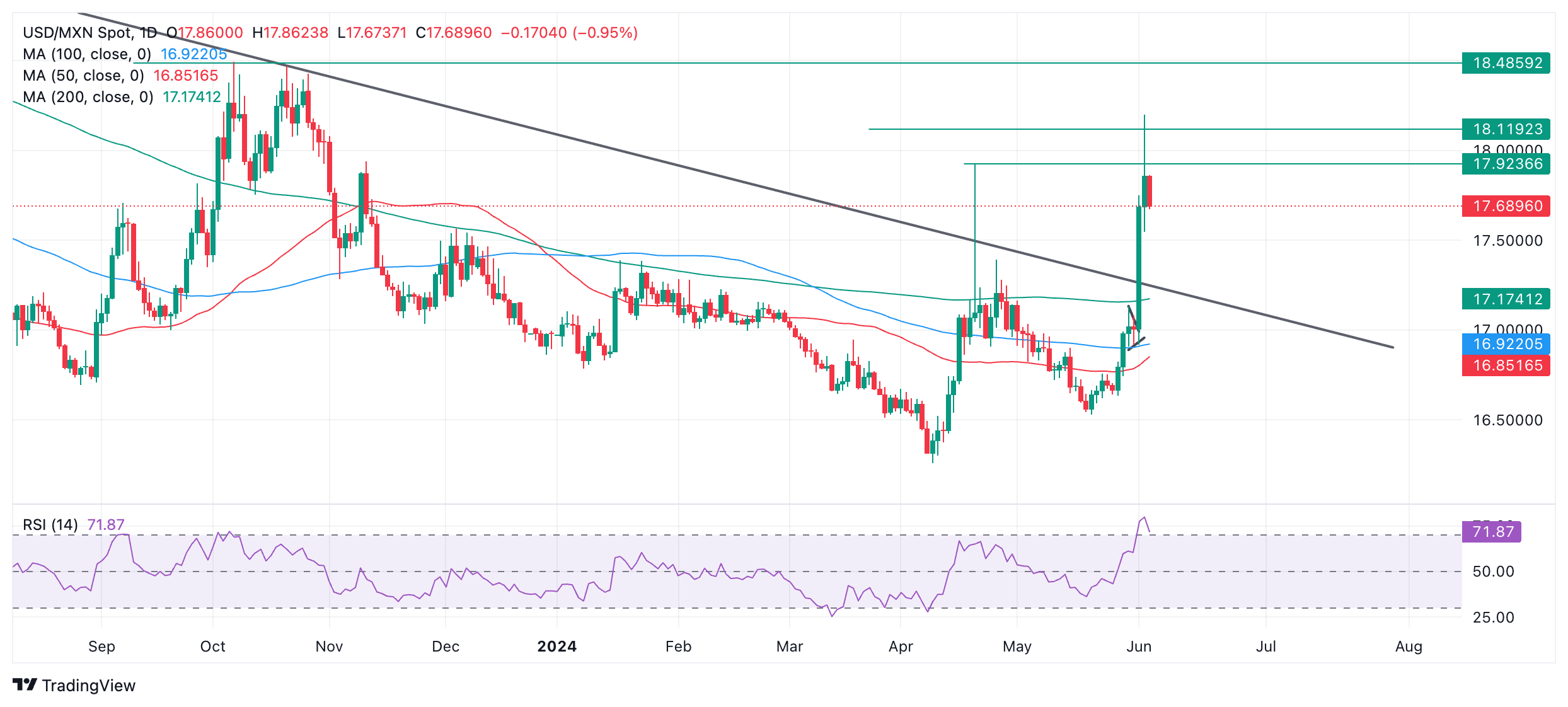- The Mexican Peso recovers on Wednesday after the Mexican Finance Minister gives an interview seeking to calm investor fears.
- Rogelio Ramírez de la O says the newly elected government will exercise fiscal discipline and encourage investment.
- USD/MXN pulls back after becoming overbought and touching a major Moving Average in the weekly timeframe, but bulls still dominate.
The Mexican Peso (MXN) recovers by more than one percent in its most traded pairs on Wednesday, after the Mexican Finance Minister, Rogelio Ramírez de la O, steps in to prevent a further depreciation of the Peso following the 5.0% election-related decline on Monday and Tuesday.
Ramírez de la O emphasized that the newly elected government would exercise fiscal discipline and ensure the continued smooth flow of foreign and domestic investment. His remarks helped ease investor fears about the sweeping changes the left-leaning Claudia Sheinbaum administration might make given its predicted large majority.
USD/MXN is exchanging hands at 17.61 at the time of writing, EUR/MXN is trading at 19.15 and GBP/MXN at 22.50.
Mexican Peso recovers after De la O intervention
The Mexican Peso recovers on Wednesday after a massive decline following Sunday’s election after Finance Minister De la O said: “We want to confirm to international organizations and private investors that our project is based on financial discipline, abiding by the autonomy of the Bank of Mexico, adherence to the rule of law and facilitating national and foreign private investment,” according to El Financiero.
Although all the votes from the Mexican election have not yet been counted – final results are expected on June 8 – estimates suggest the Morena party has probably won a supermajority (over two-thirds) in the lower house of the Mexican Parliament and an almost-supermajority in the Senate. It is now also certain Dr. Claudia Sheinbaum will be the next president of Mexico.
The Mexican Peso dropped like a stone on the news of the election, however, as investors feared that with a supermajority, Sheinbaum’s legislation would be able to enact changes to the constitution that could hurt the economy.
As if to prove investors right, economic data out from Mexico on Tuesday showed an unexpected slowdown in Gross Fixed Investment, which grew 3.0% year-over-year in March from 12.5% in February. Whilst investment in construction remained strong (9.4%), it fell 4.7% for transportation equipment. On a monthly basis, however, the metric showed a faster 0.8% growth rate compared to the previous month’s 0.7%, according to data from INEGI.
Investors will be watching Mexican Consumer Confidence data for May, which will be released on Wednesday at 12:00 GMT for more information about the economy.
Technical Analysis: USD/MXN retreats from 100-week SMA
USD/MXN – or the number of Pesos that can be bought with one US Dollar – soared and hit its second upside target at 18.12 (100-week Simple Moving Average) on Tuesday. It has retreated back down to below the April 19 high of 17.82 since then.
The pair surged following the presidential election on Sunday, and both the short and intermediate-term trends are probably now bullish, overall favoring bullish over bearish bets and more upside over those time frames (up to six months).
USD/MXN Daily Chart
A continuation of the uptrend could see USD/MXN reach the next target at 18.49 (October 2023 high).
USD/MXN is overbought according to the Relative Strength Index (RSI), and this increases the chances of a deeper correction unfolding. Given the dominance of the bullish trend, however, the pair is expected to recover and continue pushing higher. However, there are no signs yet that the pullback has ended, suggesting more downside could come before the pair finds its feet.
One possible level where the pullback could find support is at 17.34, the midpoint of the long green Japanese Marabuzo candlestick pattern that formed during Monday’s rally (June 3). If that level is surpassed, the old trendline in the 17.10s is likely to offer support. If that area is broken, it could be a sign the short and intermediate-term trends may have reversed.
The long-term trend is probably still bearish, suggesting a risk of a reversal lower remains in the background if the uptrend runs out of steam and price starts to plummet. Although price is pulling back, it is not strong enough yet to suggest a change of trend.
Banxico FAQs
The Bank of Mexico, also known as Banxico, is the country’s central bank. Its mission is to preserve the value of Mexico’s currency, the Mexican Peso (MXN), and to set the monetary policy. To this end, its main objective is to maintain low and stable inflation within target levels – at or close to its target of 3%, the midpoint in a tolerance band of between 2% and 4%.
The main tool of the Banxico to guide monetary policy is by setting interest rates. When inflation is above target, the bank will attempt to tame it by raising rates, making it more expensive for households and businesses to borrow money and thus cooling the economy. Higher interest rates are generally positive for the Mexican Peso (MXN) as they lead to higher yields, making the country a more attractive place for investors. On the contrary, lower interest rates tend to weaken MXN. The rate differential with the USD, or how the Banxico is expected to set interest rates compared with the US Federal Reserve (Fed), is a key factor.
Banxico meets eight times a year, and its monetary policy is greatly influenced by decisions of the US Federal Reserve (Fed). Therefore, the central bank’s decision-making committee usually gathers a week after the Fed. In doing so, Banxico reacts and sometimes anticipates monetary policy measures set by the Federal Reserve. For example, after the Covid-19 pandemic, before the Fed raised rates, Banxico did it first in an attempt to diminish the chances of a substantial depreciation of the Mexican Peso (MXN) and to prevent capital outflows that could destabilize the country.


























